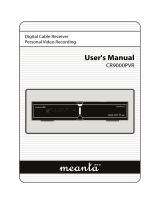
OPERATION MANUAL
ENGLISH
Contents .........................................................................................1
Dear SHARP customer ..................................................................2
Important Safety Precautions ......................................................2
Trademarks ....................................................................................2
Supplied accessories ....................................................................3
Preparation ....................................................................................3
Attaching the speaker unit ........................................................3
Attaching the stand unit ............................................................4
Detaching the stand unit ...........................................................4
Removing the terminal cover .....................................................4
Setting the TV ...........................................................................5
TV (Front view) ..........................................................................6
TV (Rear view) ...........................................................................6
Inserting the batteries ................................................................7
Using the remote control unit ....................................................7
Cautions regarding the remote control unit ...........................7
Remote control unit...................................................................8
Initial installation ...........................................................................9
Initial installation overview ..........................................................9
Initial installation wizard ...........................................................10
Positioning/aligning DVB-T antenna ...................................11
Daily operation .............................................................................12
Switching on/off ......................................................................12
TV indicator status .............................................................12
Changing channels .................................................................12
Selecting external video source ...............................................13
Operation without remote control ............................................13
Status display .........................................................................13
Additional DVB options ......................................................13
Connecting external devices ......................................................14
Note on higher picture and sound quality ................................14
Connection wizard ..................................................................15
HDMI connection ...............................................................16
VGA/XGA connection (PC/SetTopBox) ...............................16
Component connection (EXT3) ..........................................17
PC compatibility chart ........................................................18
Controlling HDMI devices using AQUOS LINK .........................19
Connecting HDMI device to TV ...............................................19
AQUOS LINK setup ...........................................................20
AQUOS LINK One Touch Recording ..................................20
Operating an AQUOS LINK device .....................................21
Listening with the AQUOS Audio speaker system .........21
Manually changing AQUOS Audio speaker system’s
sound mode ...............................................................21
Playback of titles using AQUOS LINK ...........................21
Selecting media type for CEC-compatible recorder .......21
HDMI device selection ..................................................21
Recording via the AQUOS Recorder EPG (only for
recorder) ....................................................................22
Using AV Link function ............................................................22
Speaker/amplifier connection ..................................................22
Other features ..............................................................................23
Picture in Picture (PIP) .............................................................23
Using the PIP menu ...........................................................23
Using PhotoViewer .................................................................24
Watching photos ................................................................24
Watching Slide show .........................................................25
Using PhotoViewer menu ...................................................25
EPG (Electronic Programme Guide) .........................................26
Using EPG menu ...............................................................27
Contents
• The illustrations and on-screen displays in this operation manual are for explanation purposes and may vary slightly from the
actual operations.
• The examples used throughout this manual are based on the LC-52HD1E model.
WARNING:
This is a Class A product. In a domestic environment this product may cause radio interference in which case
the user may be required to take adequate measures.
Watching DVB broadcasts ..........................................................28
Conditional Access Module (CI Module) ..................................28
Software update .....................................................................29
Radio mode ............................................................................30
Menu operation............................................................................31
Info display and index feature ..................................................31
Using info text ....................................................................31
Using Index ........................................................................31
Picture menu ..........................................................................32
AV mode ............................................................................32
Sound menu ...........................................................................32
Dolby Virtual Speaker ...................................................33
Recording menu .....................................................................33
Recording wizard ..........................................................33
Timer list .......................................................................34
Pre- and post record time .............................................34
Timer recording with external devices ................................34
Connections menu ..................................................................35
AV setup .......................................................................35
Antenna DVB ................................................................35
AV Link .........................................................................35
Miscellaneous ...............................................................35
Setup menu ............................................................................36
Stations ........................................................................36
Child lock......................................................................37
Timer functions .............................................................38
PIP ...............................................................................38
Language .....................................................................38
Miscellaneous ...............................................................38
Extended functions menu .......................................................38
Geometry menu ......................................................................38
Other menu items ...................................................................38
External Sources ................................................................38
Still image ..........................................................................38
Wide modes ......................................................................39
Teletext ...................................................................................39
Using teletext menu ...........................................................40
HDD Digital Recorder operation ................................................41
Important information ..............................................................41
Features ..................................................................................42
About time shift viewing and archive recording/playback .........43
Navigating the Digital Recorder menu .....................................44
Setting pre-record time and post record time ................44
Recording with the HDD .........................................................45
Buttons for HDD operation ......................................................45
Recording ...............................................................................46
Timer recording..................................................................47
Playback .................................................................................48
Editing ....................................................................................49
Bookmark ...............................................................................51
Appendix ......................................................................................52
Troubleshooting ......................................................................52
RS-232C port specifications ...................................................53
Using the universal remote control ..........................................55
Specifications .........................................................................59
Optional accessories ...............................................................59
End of life disposal ..................................................................60
ENGLISH
1
LC-52HD1E-gb.indd 1LC-52HD1E-gb.indd 1 2008/03/24 15:00:272008/03/24 15:00:27




















